 76a
76a
 76b
76b
 76c
76c
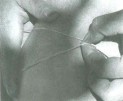 76d
76d
Stripping bark off saplings for making string (76a), Separating bast fibre from bark for making string (76b), Twisting the kuwmiy strands of string (76c), Twisting the kuwmiy strands of strong - close-up (76d)
The numerous items using string (71.5%) illustrate how important string was. The time spent on string manufacture was the most time-consuming of women's manufacturing tasks (Plates 76-101 illustrate parts of the manufacturing process and some of the many ways in which string was used [all from Sillitoe 1988]) . 'Soft' organic material (rattan, bark fibre, bamboo etc.) constitutes the majority of the raw materials used; almost all items made had a 'soft' raw material as a component part. 'Soft' raw materials survive only rarely in prehistoric archaeological contexts.
Query database for items made from: String
 76a
76a
 76b
76b
 76c
76c
 76d
76d
Stripping bark off saplings for making string (76a), Separating bast fibre from bark for
making string (76b), Twisting the kuwmiy strands
of string (76c), Twisting the kuwmiy strands
of strong - close-up (76d)
 77
77
A woman called Ponpin netting a man's apron, together with
her small son
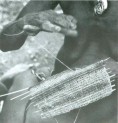 78a
78a
 78b
78b
 78c
78c
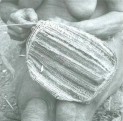 78d
78d
Examples of the use of string: Netting the crown of a fancy net-cap (78a), The pondijp netting stitch
on a fancy net-cap (78b), The shuwmat netting stitch
on a fancy net-cap (78c), Netting wesaembow kaeray
circuits on a fancy net-cap (78d)
 79a
79a
 79b
79b
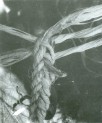 79c
79c
 79d
79d
Examples of the use of string: The lay of a twisted pig tether (79a), The doinj plait of a pig tether (79b), Plaiting a wood insert pig tether (79c), Stretching and rubbing a pig tether (79d)
 80a
80a
 80b
80b
 80c
80c
Examples of the use of string: Stringing a mouth bow (80a), Cutting off a piece of cane bamboo
stem for a tube of a pan-pipe (80b), The binding around the tubes of a
pan-pipe (80c)
 81a
81a
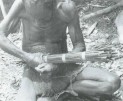 81b
81b
 81c
81c
 81d
81d
Examples of the use of string: Poking folded pieces of screw-pine
leaf under the binding around the grass stem core of a
cylindrical pendant (81a), Winding string around the end of a
cylindrical pendant (81b), The binding around the centre of a
cylindrical pendant (81c), Pushing she-oak twigs into the end
of a cylindrical pendant (81d)
 82a
82a
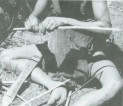 82b
82b
 82c
82c
 82d
82d
Examples of the use of string: The securing of a twisted fern fibre
loop for an elbow bangle (82a), Folding a length of cane bamboo into
a stay for an elbow bangle (82b), Arranging the loops in a cascade for
an elbow bangle (82c), Fitting a completed elbow bangle on
wearer's arm (82d)
 83a
83a
 83b
83b
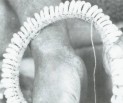 83c
83c
Examples of the use of string: Attaching cowrie shells to a
side-mounted necklace (83a), Securing cowrie shells to a
side-mounted necklace (83b), The tobok liy binding
around the base of cowrie shells on a side-mounted necklace (83c)
 84a
84a
 84b
84b
 84c
84c
 84d
84d
 84e
84e
Examples of the use of string: Starting to sew shells from an old
nassa shell forehead band onto a new bark-cloth foundation (84a), The front of a nassa shell forehead band showing stitching of shells (84b), The rear of the bark-cloth
foundation of a nassa shell forehead band showing detail of a
stitch (84c), Sewing shells onto a nassa shell
forehead band (84d), The securing of the string head-ties
to the bark-cloth foundation of a nassa shell forehead band (84e)
 85a
85a
 85b
85b
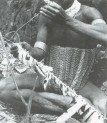 85c
85c
 85d
85d
 85e
85e
Examples of the use of string:
The dezbilay stitch use in
coiling a pompom (85a),Coiling and stitching a pompom (85b), Securing feathers to a standing line for a feather circlet (85c), The turn taken around the quill of
feathers being secured to a standing line for a feather
circlet (85d), The turn taken around the standing
line when fastening feathers to it for a feather circlet (85e)
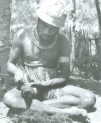 86a
86a
 86b
86b
 86c
86c
 86d
86d
 86e
86e
Examples of the use of string: Stuffing a Princess Stephanie's bird of paradise skin with moss (86a), Sewing up a bird skin after stuffing it (86b), Tying cassowary feathers onto a standing line (86c), The half-hitch around the quills of a bunch of cassowary feathers to secure them to a standing line (86d), The half-hitch around the standing line to fasten a bundle of attached cassowary feathers (86e)
An idea of the time-consuming nature of string making can be gauged from the following description.
"She strips the bark off the saplings she collects and peels the cambium fibre...away from the outer bark or shongol (lit. skin) which she discards. She allows the bark to dry first before stripping off its fibre, slitting the wands gathered lengthwise in two and placing them indoors over a fire, leaving them for about a week. But the fibre of ponjip figs, she may strip off green and dry separately; women often excoriate these saplings during collection, returning home with bags of unseparated bark..., and there peeling off and drying the bast. On average, 5g of dry phloem fibre will produce 10 metres of string.
A woman shreds the dry fibre into thin strands called ya diyr to make string, and twists these into threads or kuwmiy by rolling a few pieces at a time between her thigh and palm away from her body. She produces continuous lengths of kuwimy by twisting these fibre strands one to another. String consists of two such kuwimy threads rolled together between thigh and palm to give a two-stranded twine called kobel. A woman rolls it in two movements, pushing her hand down her thigh to twist the two strands together and then pulling it back up again to firm their lay. She twists the kuwimy threads and kobel twine simultaneously, adding ya diyr strands to the former and rolling them until c. 20cm long, and then entwining them together into string, proceeding until she has a sizeable hank."
(Sillitoe 1988, 245).
The time for making enough string for an apron totals 12 hours, 43 minutes and 45 seconds. (The apron takes another 60 hours, 51 minutes 45 seconds to weave.)
MacKenzie (1991) gives a very detailed description of string making that includes the heating process for isolating the bast fibres, the methods of drying the fibres, the moistening of the fibres before twisting as well as the actual spinning process itself. Her time estimates differ slightly to those described above though this may be related to the amount of string being prepared, with up to 14 hours over a period of two weeks required for separation, and preparation of the fibres, then around 60 hours worth of spinning to produce enough string to make an average sized bilum.
These accounts serve to illustrate the time-consuming nature of string making. While making string will have varied according to the raw materials used in different environmental zones, all string making using natural resources requires a lengthy preparation time even before spinning takes place. String making will have been a time-consuming occupation for any society that employed string to manufacture items of material culture or clothing. Though Sillitoe only found women string makers, MacKenzie met one male string maker while Hampton comments that both men and women rolled the fibres to twist them into string (Sillitoe 1988; MacKenzie 1991; Hampton 1999).
 87a
87a
 87b
87b
 87c
87c
Examples of the use of string: Trimming the sedge of a skirt to size (87a), Making the string front of a fancy skirt (87b), The serial whipping along the top edge of the string front of a fancy skirt (87c)
 88a
88a
 88b
88b
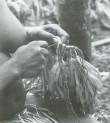 88c
88c
 88d
88d
Examples of the use of string: Flattening sedge stems for a skirt (88a), Whipping a bundle of sedge onto a skirt (88b), Whipping stout bundles of sedge onto the rear of a skirt (88c), A half-hitch securing the whipping around a bundle of sedge on the rear of a skirt (88d)
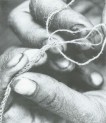 89a
89a
 89b
89b
 89c
89c
Examples of the use of string: The first shuwmat purl row of a knitted wristband (89a), Completing the final row of a knitted wristband (89b), Sewing cowrie shells on to a knitted wristband (89c)
 90a
90a
 90b
90b
 90c
90c
Examples of the use of string: Dyeing string with wad of purple coleus leaves (90a), Splitting up a screw-pine leaf for netting spacers (90b), The standard nuw bay netting stitch (90c)
 91a
91a
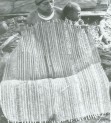 91b
91b
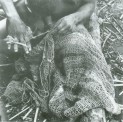 91c
91c
Examples of the use of string: An apron prior to the removal of the siris strand opening it up (91a), An apron prior to sewing the tib liy seam (91b), Netting the final tib liy seam of an apron (91c)
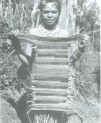 92a
92a
 92b
92b
 92c
92c
 92d
92d
Examples of the use of string: A man's knotted-strap bag prior to sewing up of seams (92a),
Netting the strap of a man's wide-strap bag (92b), The tib liy seam netting stitch (92c), The start of a wesaembow kaeray circuit around two standard netted rows (92d)
 93a
93a
 93b
93b
Examples of the use of string: Netting the final circuit on a fancy net-cap (93a), Beating a sleeve of bark fibre for a bark-cloth hat (93b)
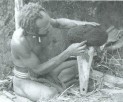 94a
94a
 94b
94b
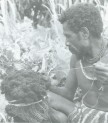 94c
94c
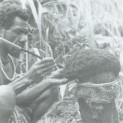 94d
94d
Examples of the use of string: Giving the finishing touches to an oval wig (94a), Covering a tree stump with netting in preparation for building a wig on it (94b), Trussing together hair for a crescent wig (94c), Prodding a crescent wig into final shape (94d)
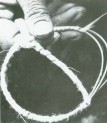 95a
95a
 95b
95b
 95c
95c
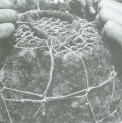 95d
95d
 95e
95e
Examples of the use of string: The construction of the kwiysh mor crown support for a wig or headdress (95a), Positioning kwiysh mor crown support on the head before building a burr wig (95b), Building up the burr foundation of a burr wig (95c), Tying the kwiysh mor crown support on a burr wig foundation (95d), Pushing hair onto the burr foundation of a burr wig (95e)
 96a
96a
 96b
96b
 96c
96c
 96d
96d
 96e
96e
 96f
96f
Examples of the use of string: Winding a bark fibre around the end of a shaft prior to binding on the tines of a pronged arrow (96a), Starting to bind the tines onto a pronged arrow (96b), The mor binding on a pronged arrow (96c-e), Whipping around the tines and shaft of a pronged arrow (96f)
 97a
97a
 97b
97b
Examples of the use of string: Lashing a sapling into a hoop for a fishing net (97a), Attaching a net bag to a sapling hoop for a fishing net (97b)
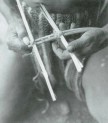 98a
98a
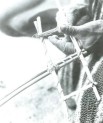 98b
98b
 98c
98c
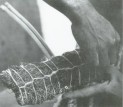 98d
98d
Examples of the use of string: Starting the frame of a hunger restrainer with two cross members (98a), Adding two end pieces to the frame of a hunger restrainer (98b), Binding up the pad of a hunger restrainer (98c), Completing the binding around a hunger restrainer (98d)
 99a
99a
 99b
99b
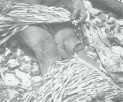 99c
99c
Examples of the use of string: Whipping sedge onto the front of a fancy skirt (99a), Threading beads and seeds on the side of a fancy skirt (99b), Smearing pig grease on a fancy skirt (99c)
 100a
100a
 100b
100b
 100c
100c
Examples of the use of string: Stitching screw-pine leaves onto a rain cape (100a), Sewing along the edge of a rain cape (100b), Sewing the centre seam of a rain cape (100c)
 101a
101a
 101b
101b
 101c
101c
 101d
101d
Examples of the use of string: Removing a strip of bark from a sapling for a bast girdle-strap (101a), Whipping the securing toggle onto the end of a bast girdle-strap (101b), Making a string girdle strap (101c), The paelonk braid pattern (101d)
© Internet Archaeology/Authors
Last updated: Wed Oct 8 2003